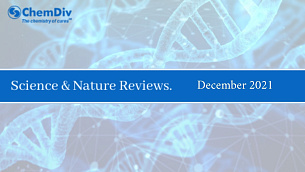Science & Nature Reviews, February 2022. Part I

Molecular biology
Rasmussen, M., Reddy, M., Nolan, R. et al. RNA profiles reveal signatures of future health and disease in pregnancy. Nature 601, 422–427 (2022)
Pre-eclampsia is a disorder of pregnancy characterized by the onset of high blood pressure, red blood cell breakdown, impaired liver function, kidney dysfunction, swelling or visual disturbances. This condition complicates up to 1 in 12 pregnancies and is a significant cause of maternal morbidity. We can’t research this disease in animals, because pre-eclampsia occurs predominantly in humans. Moreover, research into human pregnancy has clear ethical constraints. Thus the ability to assess this disease before clinical presentation to enable identification of pregnancies at risk remains elusive. On pages of Nature, researchers demonstrate the new approach based on the ability of plasma cell-free RNA to reveal patterns of normal pregnancy progression. This new method determines the risk of developing pre-eclampsia months before clinical presentation.
Drug research
Wang, Z., Koirala, B., Hernandez, Y. et al. A naturally inspired antibiotic to target multidrug-resistant pathogens. Nature 601, 606–611 (2022)
Antibiotic resistance is one of the main problems of medicine. It occurs when microbes evolve mechanisms that protect them from the effects of antimicrobials. Multidrug-resistant Gram-negative bacteria are responsible for an increasing number of deaths caused by antibiotic-resistant infections. Many Gram-negative antibiotics in current use are bacterial metabolites, for example, colistin. Colistin disrupts bacterial membrane integrity and ultimately causes cell death. Unfortunately, the extensive use of this drug in human pharmacotherapy has led to a troubling rise in resistant clinical isolates. Using chemical synthesis, scientists managed to obtain a structural analog of colistin, which is called macolacin. This drug is active against Gram-negative pathogens, which are resistant to colistin, providing a naturally inspired and easily produced therapeutic lead.
Cell engineering
Rurik, J. G., Tombacz, I., Yadegari, A. et al. CAR T cells produced in vivo to treat cardiac injury. Science 375, 6576, 91-96 (2022)
Cardiac fibrosis is a disease that commonly refers to the excess deposition of extracellular matrix in the cardiac muscle and can be fatal. It affects millions of people with cardiac disease. However, on pages of Science researchers describe a new therapeutic approach by harnessing the power of engineered CAR T cells. These cells contain synthetic receptors, called CAR, which allow immune cells—usually T cells—to recognize targeted antigens and initiate antigen-specific immune responses. Thus, these receptors can recognize the fibrotic cells in the heart, which are involved in the development of the disease. First experiments revealed that the approach was successful in reducing fibrosis and restoring cardiac function.
Physiology
Orecchioni, M., Kobiyama, K., Winkels, H. et al. Olfactory receptor 2 in vascular macrophages drives atherosclerosis by NLRP3-dependent IL-1 production. Science 375, 6577, 214-221 (2022)
Olfactory receptor, also called smell receptor, plays a central role in the sense of smell (olfaction). However, it’s not the only role of these receptors. They are also present in other tissues and perform additional biological functions. In a new issue of Science, researchers identified the contribution of olfactory receptors to atherosclerosis pathogenesis and the formation of atherosclerotic plaques. Atherosclerosis is the buildup of fats, cholesterol and other substances in and on your artery walls. The major risk is fatal complications such as heart attack and stroke, that’s why an understanding of the cells that drive disease, and how to therapeutically target them, is needed.
Structural biology
Yang, Y., Arseni, D., Zhang, W. et al. Cryo-EM structures of amyloid-β 42 filaments from human brains. Science 375, 6577, 167-172 (2022)
Alzheimer's is the most common cause of dementia, which is characterized by memory loss and other cognitive abilities and mature amyloid fibrils that form amyloid plaques. In new research, scientists describe the structures of fibrils that were extracted from the brain tissue of patients with neurodegenerative diseases. These structures will inform the development of better in vitro and animal models and strategies for disease-modifying therapeutic intervention or diagnosis.
Rasmussen, M., Reddy, M., Nolan, R. et al. RNA profiles reveal signatures of future health and disease in pregnancy. Nature 601, 422–427 (2022)
Pre-eclampsia is a disorder of pregnancy characterized by the onset of high blood pressure, red blood cell breakdown, impaired liver function, kidney dysfunction, swelling or visual disturbances. This condition complicates up to 1 in 12 pregnancies and is a significant cause of maternal morbidity. We can’t research this disease in animals, because pre-eclampsia occurs predominantly in humans. Moreover, research into human pregnancy has clear ethical constraints. Thus the ability to assess this disease before clinical presentation to enable identification of pregnancies at risk remains elusive. On pages of Nature, researchers demonstrate the new approach based on the ability of plasma cell-free RNA to reveal patterns of normal pregnancy progression. This new method determines the risk of developing pre-eclampsia months before clinical presentation.
Drug research
Wang, Z., Koirala, B., Hernandez, Y. et al. A naturally inspired antibiotic to target multidrug-resistant pathogens. Nature 601, 606–611 (2022)
Antibiotic resistance is one of the main problems of medicine. It occurs when microbes evolve mechanisms that protect them from the effects of antimicrobials. Multidrug-resistant Gram-negative bacteria are responsible for an increasing number of deaths caused by antibiotic-resistant infections. Many Gram-negative antibiotics in current use are bacterial metabolites, for example, colistin. Colistin disrupts bacterial membrane integrity and ultimately causes cell death. Unfortunately, the extensive use of this drug in human pharmacotherapy has led to a troubling rise in resistant clinical isolates. Using chemical synthesis, scientists managed to obtain a structural analog of colistin, which is called macolacin. This drug is active against Gram-negative pathogens, which are resistant to colistin, providing a naturally inspired and easily produced therapeutic lead.
Cell engineering
Rurik, J. G., Tombacz, I., Yadegari, A. et al. CAR T cells produced in vivo to treat cardiac injury. Science 375, 6576, 91-96 (2022)
Cardiac fibrosis is a disease that commonly refers to the excess deposition of extracellular matrix in the cardiac muscle and can be fatal. It affects millions of people with cardiac disease. However, on pages of Science researchers describe a new therapeutic approach by harnessing the power of engineered CAR T cells. These cells contain synthetic receptors, called CAR, which allow immune cells—usually T cells—to recognize targeted antigens and initiate antigen-specific immune responses. Thus, these receptors can recognize the fibrotic cells in the heart, which are involved in the development of the disease. First experiments revealed that the approach was successful in reducing fibrosis and restoring cardiac function.
Physiology
Orecchioni, M., Kobiyama, K., Winkels, H. et al. Olfactory receptor 2 in vascular macrophages drives atherosclerosis by NLRP3-dependent IL-1 production. Science 375, 6577, 214-221 (2022)
Olfactory receptor, also called smell receptor, plays a central role in the sense of smell (olfaction). However, it’s not the only role of these receptors. They are also present in other tissues and perform additional biological functions. In a new issue of Science, researchers identified the contribution of olfactory receptors to atherosclerosis pathogenesis and the formation of atherosclerotic plaques. Atherosclerosis is the buildup of fats, cholesterol and other substances in and on your artery walls. The major risk is fatal complications such as heart attack and stroke, that’s why an understanding of the cells that drive disease, and how to therapeutically target them, is needed.
Structural biology
Yang, Y., Arseni, D., Zhang, W. et al. Cryo-EM structures of amyloid-β 42 filaments from human brains. Science 375, 6577, 167-172 (2022)
Alzheimer's is the most common cause of dementia, which is characterized by memory loss and other cognitive abilities and mature amyloid fibrils that form amyloid plaques. In new research, scientists describe the structures of fibrils that were extracted from the brain tissue of patients with neurodegenerative diseases. These structures will inform the development of better in vitro and animal models and strategies for disease-modifying therapeutic intervention or diagnosis.



